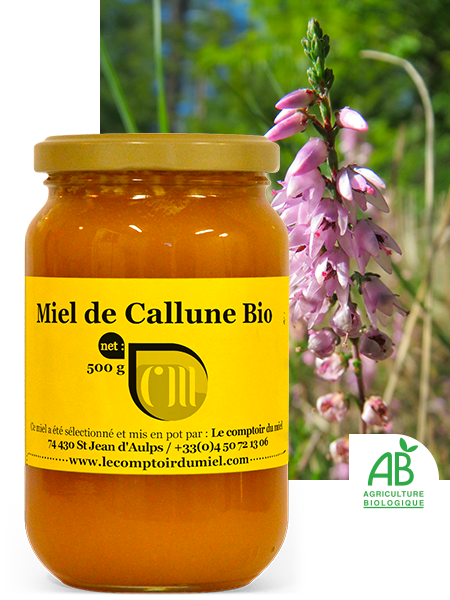Heather and Callune are melliferous plants. Autumn heather honey comes from Callune. It is a dark-brown honey with a persistent odor and aroma, often in jelly form.
Ashy heather is fairly common in the western half of France, the Pyrenees and Cévennes, where it can reach altitudes of up to 1,500 m. However, it is rare in the east and in the Alps.
Callune is common almost everywhere in France, and can be found at altitudes of up to 2,500 m.
Harvested between September and October, organic Callune honey is produced in the Landes region of France. To extract Callune, you need a picoteuse. Picoteuses were invented in the 18th century to extract thick, dense honey. In other words, Callune honey is extracted twice!
Callune honey, which has a very high water content, has a dense consistency that requires support to extract it from the comb where the bees made and stored it.
The taste, flavor and aroma of organic Callune honey:
BIO Callune honey has a slightly bitter taste and a gelatinous consistency. Its fragrance reflects the taste, dense and pronounced.
Beware: this honey does not keep well, as it is very rich in water. In fact, it’s one of the few honeys with such a high water content!
It can also be enjoyed directly from the shelf. Callune (also known as common heather) is a summer-flowering perennial honey plant. Its flowers are purplish-pink and grouped in spikes. Callune grows easily in undergrowth, and can be found both in the countryside and in the mountains, where it provides food for sheep and deer in winter.
The benefits and properties of organic Callune :
Rich in trace elements and mineral salts, organic Callune honey is said to be diuretic and ideal for people suffering from urinary tract infections.
It is also rich in minerals such as manganese, magnesium and phosphorus. Not to be underestimated for our health.
Did you know?
Contrary to popular belief, callune does not belong to the Erica genus but to the genus Calluna with just one species: Calluna vulgaris . Heather belongs to the Erica genus, which comprises 11 species in France, characterized by a bell-shaped corolla.
